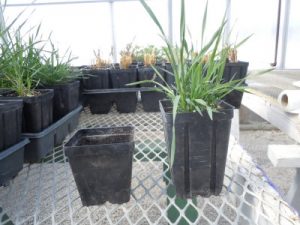
All plants that we send are “ready for prime time” (Saturday Night Live.) They can be planted outside and should be planted outside promptly after you receive them.
Plants we send are either in pots or bareroot.
Potted plants come in either what we call 3” pots or 4″ pots. Both of the pots are square, not round.
Dimensions of the 3” pots are 3 ½ inches across at the top, sloping toward the bottom which is 2 ½ inches across at the bottom. They are 3 ½ inches in height. These pots hold 16 oz. of potting soil be volume. We use these for plants that have shallow roots.
We send larger plants bareroot. That means we take the dirt off the roots.
We wrap the roots of bareroot plants in moist, recycled newspaper and then wrap all that in a plastic bag secured with tape. Why do we remove the dirt? A combination of reasons: it does not harm the plants and moist dirt is heavy, unnecessarily resulting in costly shipping charges.
We cannot tell you how big a bareroot plant will be because each one is different. At Heritage Flower Farm we grow more than 1000 different kinds of plants – from tiny to big. Every kind of plant is different. Many have different kinds of stems and different kinds of roots.
Have we ever had a problem with plants surviving? Here are two instructive events:
We sent some plants, as requested, to a PO Box in New York. No one ever claimed them so the post office returned the box with the plants. The plants sat in an unopened box at the post office for 2 weeks. When we opened the box we noticed some green still on the plants so we thought we’d give them a chance. We potted them up, watered them well and they came back from their near-death experience.
On the other hand we once lost some plants. We sent them to Chicago – only 90 miles away. The postal worker promised they would arrive within a few days even if we did not send them Priority Mail. The weather was record-breaking hot. The postal worker was wrong and it took about 8 days to go 90 miles! Some, but not all, of those plants turned to mush. Lesson learned. Since then we ALWAYS send plants Priority Mail, regardless of the distance. And we wait to send plants if the weather is too hot or cold.
